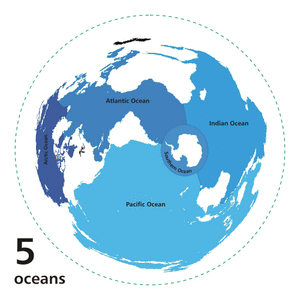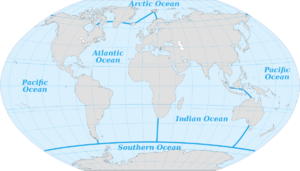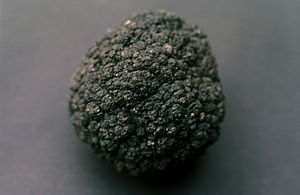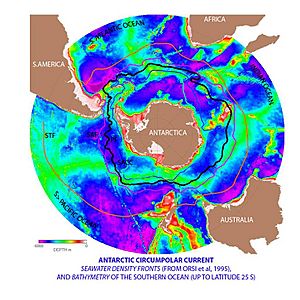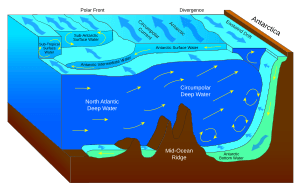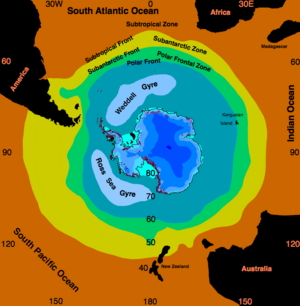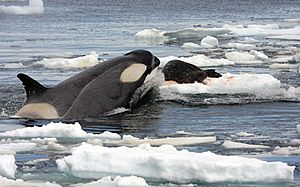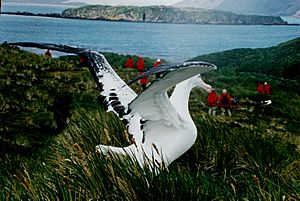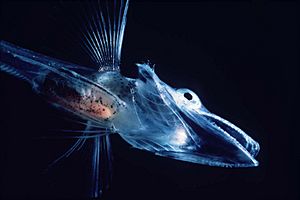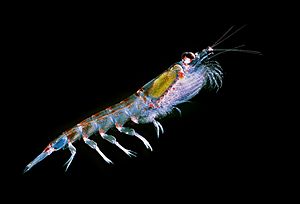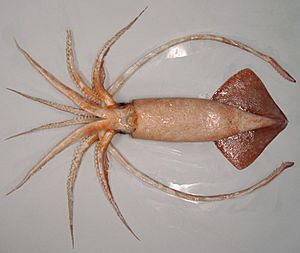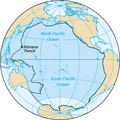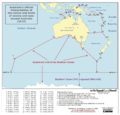Southern Ocean facts for kids
| Earth's ocean |
|---|
|
Main five oceans division: Further subdivision: Marginal seas |
The Southern Ocean is the ocean that surrounds Antarctica. It was officially recognized as a separate ocean in 2000. It includes parts of the Atlantic, Pacific, and Indian Oceans that are south of 60 degrees south latitude. Some people also call it the Antarctic Ocean.
This ocean covers a huge area of about 20,327,000 square kilometers (7,848,000 square miles). Its coastline around Antarctica is 17,968 kilometers (11,165 miles) long.
Contents
Geography
The Southern Ocean is the youngest of all the oceans. It formed about 30 million years ago when Antarctica and South America drifted apart. This movement created the Drake Passage, which allowed a powerful ocean current to form around Antarctica.
Unlike other oceans, the Southern Ocean's northern border doesn't touch a landmass. Instead, it meets the Atlantic, Indian, and Pacific Oceans at 60°S latitude.
One reason scientists consider it a separate ocean is because its water is unique. A strong current called the Antarctic Circumpolar Current moves water very quickly around Antarctica. This means the water south of, say, New Zealand is more like the water south of South America than it is like the water in the Pacific Ocean.
The Southern Ocean is usually very deep, often between 4,000 and 5,000 meters (13,000 to 16,000 feet) deep. The deepest point is 7,236 meters (23,740 feet) in the South Sandwich Trench. The Antarctic continental shelf (the underwater edge of the continent) is narrow and unusually deep, reaching up to 800 meters (2,600 feet) deep.
The amount of sea ice around Antarctica changes a lot with the seasons. In March, it's at its smallest, covering about 2.6 million square kilometers (1 million square miles). By September, it grows to about 18.8 million square kilometers (7.3 million square miles), which is more than seven times bigger!
Parts of the Southern Ocean
The Southern Ocean has many smaller parts, like "seas," "straits," and "bays." Some of these include:
- Weddell Sea
- King Haakon VII Sea
- Lazarev Sea
- Riiser-Larsen Sea
- Cosmonauts Sea
- Cooperation Sea
- Davis Sea
- Mawson Sea
- Dumont D'Urville Sea
- Somov Sea
- Ross Sea
- Amundsen Sea
- Bellingshausen Sea
- Part of the Drake Passage
- Bransfield Strait
- Part of the Scotia Sea
Some of these names, like "Cosmonauts Sea" and "Somov Sea," were suggested later and are not used by all mapmakers, even though they appear on some Russian maps.
Natural Resources
The Southern Ocean likely holds large amounts of oil and natural gas under the seafloor. There might also be valuable minerals like gold in "Placer deposits," which are formed when heavy minerals settle together.
Manganese nodules are also expected to be found here. These are rock lumps on the sea bottom. They are made of layers of iron and manganese minerals around a small core. People were very interested in mining these in the 1960s and 1970s.
The icebergs that form each year in the Southern Ocean contain enough fresh water to supply everyone on Earth for several months. For many years, there have been ideas to tow these icebergs to dry northern areas, like Australia, to use their fresh water. However, this has not been successful yet.
Natural Hazards
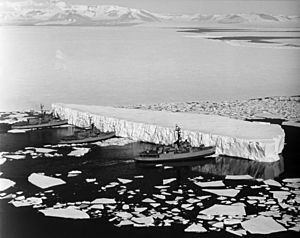
Icebergs are a danger to ships in the Southern Ocean all year round. Some icebergs can be hundreds of meters deep. Smaller icebergs and sea ice (about 0.5 to 1 meter thick) also make sailing difficult.
Sailors call the latitudes from 40 to 70 degrees south the "Roaring Forties," "Furious Fifties," and "Shrieking Sixties." This is because of the very strong winds and huge waves that form here. The winds can blow around the entire globe without hitting any land. Icebergs, especially from May to October, make these areas even more dangerous. Also, because the region is so far away, it's hard to get help if a ship is in trouble.
Physical Oceanography
Antarctic Circumpolar Current and Antarctic Convergence
The Antarctic Circumpolar Current (ACC) flows continuously eastward around Antarctica. At 21,000 kilometers (13,000 miles) long, it's the world's longest ocean current. It moves an incredible amount of water – 100 times more than all the world's rivers combined!
Along the coast of Antarctica, special types of water masses form that are not found anywhere else in the Southern Hemisphere. One is the Antarctic Bottom Water, which is very cold, salty, and dense. It forms under the sea ice.
The Antarctic Convergence is a zone linked to the Circumpolar Current. It's where the cold waters flowing north from Antarctica meet the warmer waters from the subantarctic region. The colder Antarctic water sinks beneath the warmer water. This mixing creates an area rich in nutrients. These nutrients support a lot of tiny phytoplankton, which are eaten by small creatures like copepods and Antarctic krill. This forms a food chain that supports fish, whales, seals, penguins, albatrosses, and many other animals.
The Antarctic Convergence is often seen as the natural northern boundary of the Southern Ocean.
Upwelling
A lot of upwelling happens in the Southern Ocean. Upwelling is when deep, cold water rises to the surface. Strong westerly winds blow around Antarctica, pushing a lot of water northward. Because there are no continents to block the flow between South America and the Antarctic Peninsula, some of this water is pulled up from great depths. This upwelling is a main way that deep, dense water comes to the surface of the ocean.
Ross and Weddell Gyres
The Ross Gyre and Weddell Gyre are two large circular ocean currents, or gyres, found in the Southern Ocean. The Ross Gyre is in the Ross Sea, and the Weddell Gyre is in the Weddell Sea. Both of them spin clockwise. These gyres are created by the interaction between the Antarctic Circumpolar Current and the Antarctic Continental Shelf.
Sea ice often stays in the center of the Ross Gyre. Scientists have noticed that the water in the Ross Gyre has become less salty since the 1950s, possibly due to global warming.
Because of the Coriolis effect and Ekman transport, these areas are very productive. Cold, nutrient-rich water rises to the surface, supporting a lot of marine life.
Climate
Sea temperatures in the Southern Ocean range from about -2 to 10 °C (28 to 50 °F). Storms often travel eastward around Antarctica and can become very strong. This is because of the big temperature difference between the ice and the open ocean. The area from about 40 to 70 degrees south latitude has the strongest average winds on Earth.
In winter, the ocean freezes far out from the continent. In the Pacific part, ice can reach 65 degrees south latitude, and in the Atlantic part, it can reach 55 degrees south latitude. This makes surface temperatures well below 0 degrees Celsius (32 °F). However, in some coastal areas, strong winds from inland keep the shoreline free of ice all winter.
Biodiversity
Animals
Many different marine animals live in the Southern Ocean. They all depend, directly or indirectly, on the tiny phytoplankton. Antarctic sea life includes penguins, blue whales, orcas, colossal squids, and fur seals.
The emperor penguin is the only penguin that breeds during the winter in Antarctica. The Adélie penguin breeds further south than any other penguin. The rockhopper penguin has cool feathers around its eyes that look like eyelashes. King penguins, chinstrap penguins, and gentoo penguins also breed in the Antarctic region.
The Antarctic fur seal was hunted a lot in the 1700s and 1800s for its fur. The Weddell seal is named after Sir James Weddell, who led British sealing trips. Antarctic krill are tiny shrimp-like creatures that gather in huge groups. They are a "keystone species" in the Southern Ocean, meaning many other animals depend on them for food. Whales, seals, leopard seals, fur seals, squid, icefish, penguins, albatrosses, and many other birds eat krill.
The animals living on the seafloor, called "benthic" communities, are very diverse and numerous. You can find up to 155,000 animals in just one square meter (about 11 square feet)! Because the seafloor around Antarctica is quite similar everywhere, hundreds of species can be found all around the continent. This is a very wide distribution for such a large group of animals. Many of these deep-sea animals show "Deep-sea gigantism," meaning they are much larger than their relatives in other parts of the world.
A study of sea life in 2010 found something amazing: more than 235 marine animals live in both the Arctic and Antarctic regions, even though they are 12,000 kilometers (7,500 miles) apart! Large animals like some whales and birds travel between the poles every year. But even small creatures like mudworms, sea cucumbers, and snails were found in both polar oceans. This might be because the deep ocean temperatures are similar at the poles and the equator, and major ocean currents can carry eggs and larvae.
Birds
The rocky coasts of Antarctica and its nearby islands are nesting places for over 100 million birds every spring. These birds include different kinds of albatrosses, petrels, skuas, gulls, and terns. The South Georgia pipit, a bird that eats insects, lives only on South Georgia and some smaller islands nearby. Freshwater ducks live on South Georgia and the Kerguelen Islands.
All penguins, which cannot fly, live in the Southern Hemisphere. Most of them are found on and around Antarctica. Four of the 18 penguin species live and breed on the Antarctic mainland and its close islands. Another four species live on the subantarctic islands. Emperor penguins have four layers of feathers to keep them warm. They are the only Antarctic animal that breeds during the winter.
Fish
There are not many different types of fish families in the Southern Ocean, but some families have many species. The most common are snailfish, followed by cod icefish and eelpout. Together, these groups make up almost 90% of the more than 320 known fish species in the Southern Ocean. Many new species are still being discovered, especially among snailfish. Southern Ocean snailfish usually live in deep waters, while icefish can also be found in shallower waters.
Icefish
Cod icefish and several other families belong to a group called Notothenioidei, often just called icefish. Many species in this group have special "antifreeze proteins" in their blood and tissues. These proteins let them live in water that is at or even slightly below freezing point. Southern Ocean snailfish also have these antifreeze proteins.
The crocodile icefish (family Channichthyidae) are only found in the Southern Ocean. They are unique because they don't have hemoglobin in their blood, which means their blood is colorless! One type of crocodile icefish, the mackerel icefish, used to be very common in coastal waters. But it was overfished in the 1970s and 1980s. Schools of icefish spend the day on the seafloor and rise at night to eat plankton and smaller fish.
There are two species of Dissostichus fish: the Antarctic toothfish and the Patagonian toothfish. These fish live on the seafloor, from 100 to 3,000 meters (330 to 9,840 feet) deep. They can grow up to 2 meters (6.6 feet) long and weigh up to 100 kilograms (220 pounds), living for up to 45 years. The Antarctic toothfish lives closer to the Antarctic mainland, while the Patagonian toothfish prefers warmer subantarctic waters. Both are caught for food, and overfishing has reduced their numbers.
Another common fish group is the genus Notothenia, which also has antifreeze in its body, like the Antarctic toothfish.
An unusual icefish is the Antarctic silverfish. It's the only fish that truly lives in the open water (not near the bottom) in the waters near Antarctica.

Mammals
Seven types of pinnipeds (seals and sea lions) live in Antarctica. The largest is the elephant seal, which can weigh up to 4,000 kilograms (8,800 pounds). The smallest female, the Antarctic fur seal, weighs only about 150 kilograms (330 pounds). These two species live north of the sea ice and breed on beaches. The other four species can live on the sea ice. Crabeater seals and Weddell seals form breeding groups, while leopard seals and Ross seals live alone. Even though these seals hunt underwater, they spend a lot of time on land or ice because they have no predators there.
The four species that live on sea ice are thought to make up half of all the seals in the world. Crabeater seals have a population of about 15 million, making them one of the most common large animals on Earth. The New Zealand sea lion is very rare and mostly breeds on the Auckland Islands. Of all the mammals that live in Antarctica year-round, Weddell seals live the furthest south.
There are 10 types of cetaceans (whales and dolphins) in the Southern Ocean: six baleen whales and four toothed whales. The largest is the blue whale, which can grow to 24 meters (79 feet) long and weigh 84 tonnes. Many of these whales migrate to warmer tropical waters during the Antarctic winter.
Invertebrates
Arthropods
Five types of krill, which are small, free-swimming crustaceans, have been found in the Southern Ocean. The Antarctic krill is one of the most common animal species on Earth. Its total biomass (total weight of all individuals) is around 500 million tonnes. Each krill is about 6 centimeters (2.4 inches) long and weighs over 1 gram (0.035 ounces). They form huge swarms that can stretch for kilometers, with up to 30,000 individuals per cubic meter, turning the water red. Krill usually stay in deep water during the day and come up at night to eat plankton. Many larger animals depend on krill for survival. In winter, when food is scarce, adult Antarctic krill can even shrink back to a smaller, younger stage, using their own bodies for food.
Many crustaceans that live on the seafloor have a breeding cycle that doesn't depend on seasons. Some carry their young in a special pouch. Glyptonotus antarcticus is an unusually large seafloor isopod, growing up to 20 centimeters (7.9 inches) long and weighing 70 grams (2.5 ounces). Amphipods are common in soft sediments and eat many things, from algae to other animals. There are over 600 known species of amphipods south of the Antarctic Convergence, and many more are likely undiscovered. Some of these are "giants," like the epimeriids that can be up to 8 centimeters (3.1 inches) long.
Slow-moving sea spiders are common and can grow as large as a human hand. They eat corals, sponges, and bryozoans found on the seabed.
Others
Many aquatic molluscs live in Antarctica. Bivalves like Adamussium colbecki move around on the seafloor, while others like Laternula elliptica live in burrows, filtering water for food. There are about 70 types of cephalopods (like squid and octopuses) in the Southern Ocean. The largest is the colossal squid, which can be up to 14 meters (46 feet) long, making it one of the largest invertebrates in the world. Squid are a main food source for some animals, such as grey-headed albatrosses and sperm whales. The warty squid is one of the most hunted species by vertebrates in the subantarctic.
The sea urchin genus Abatus burrows through the sediment, eating nutrients it finds. Two types of salps are common in Antarctic waters: Salpa thompsoni and Ihlea racovitzai. Salpa thompsoni lives in ice-free areas, while Ihlea racovitzai is found closer to the ice. Salps don't have much nutrition, so larger animals usually only eat them when other food is scarce.
Antarctic sponges live for a long time and are sensitive to changes in their environment. This is because they have special symbiotic microbial communities living inside them. Because of this, they can act as indicators of how healthy the environment is.
Images for kids
-
A 1564 map by Abraham Ortelius showing an imagined link between Antarctica and South America.
-
James Weddell's second trip in 1823 with his ships, the Jane and the Beaufroy.
-
A famous portrait of Captain James Cook, who proved that water surrounded the southern parts of the globe.
-
Frank Hurley's photo of the ship Endurance trapped in ice, from the National Library of Australia.
-
The ship MS Explorer in Antarctica in January 1999. It sank in 2007 after hitting an iceberg.
-
A mother and baby Minke whale being pulled onto the Japanese whaling ship Nisshin Maru.
-
Cracks in an ice pier at McMurdo Station in 1983, which made cargo operations slow and unsafe.
See also
 In Spanish: Océano Austral para niños
In Spanish: Océano Austral para niños


